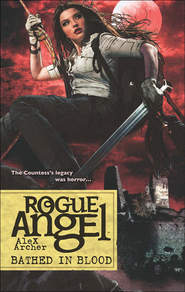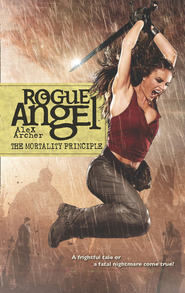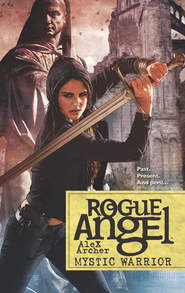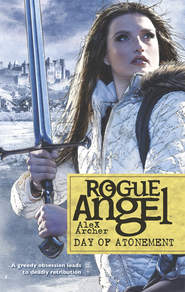По всем вопросам обращайтесь на: info@litportal.ru
(©) 2003-2025.
✖
Tribal Ways
Автор
Год написания книги
2019
Настройки чтения
Размер шрифта
Высота строк
Поля
“Oh, yes. In the mountains east of Santa Fe,” Annja said.
“That’s it. You’d be surprised how many people have only heard of the one in Nevada. Or maybe you wouldn’t. At any rate, the relationship between the Pueblos and the South Plains people was especially problematic. Sometimes the Plains folk came to the Pueblos to trade, sometimes to pillage and kill. It was the usual antagonism between settled groups and nomads.”
“I’m familiar with that,” Annja said. “So where do the Navajos come in?”
“Originally as rivals,” Watson said with a smile. “As an Apachean subgroup of the Athabascan peoples they and their fellow Apacheans also raided the prosperous and populous riparian communities. That often brought them into conflict with the South Plains people. Usually the Apache came off second best.”
Annja noted a half-hidden grin at that. That was something she’d noticed in her dealings with people of Plains Indian extraction—no matter how vocally they tried, as many did, to disavow violence and war, they remained at core warrior cultures. And thoroughly proud of their histories.
“It wasn’t perfectly straightforward, of course,” Watson said.
“Are human interactions ever?”
Watson laughed. “Not that I’ve noticed.” She shook her head, seemed to go introspective for a moment. “Anyway, one thing that happened was that the Jicarilla band of Apaches early on settled in northern New Mexico, and entered into alliance with the Taoseños. They provided security for the great annual Taos trade fairs.”
“Really? I didn’t know that.”
“Yes. So there was always considerable contact between the people of the Southwest and of the South Plains. A famous hide painting exists of a battle—at about the time of the American Revolution—between Spanish troops with Apache mercenaries and French ones alongside Comanche allies.”
“Who won?”
“The French and Comanche. I’m tempted to add of course. Anyway, the contacts, if anything, grew stronger with the conclusion of the wars of Indian subjugation. After the final surrender of the Chiricahua Apaches to the U.S. Army in the 1880s they were eventually shipped to Fort Sill in Oklahoma.”
“Which is the heart of Comanche territory.”
“Yes. About half the Nation still lives around Sill and Lawton. Of course, by the time the Chiricahua gave up their relatives the Navajo had long since come to terms with the inevitable and settled down to become sheep-herders. Meanwhile, the Chiricahua had extensive exposure to Comanche culture on the reservation.”
“I didn’t think there were any reservations in Oklahoma,” Annja said.
“There aren’t anymore. It was the usual story. The free peoples of the Plains kept being restricted to smaller and smaller chunks of less and less desirable real estate. Then as soon as they got settled in, somebody would discover something on the land they’d been ceded—gold in the Black Hills, say—and they’d be pushed off again.
“In Oklahoma the Kiowa and Comanche were both forcibly settled onto reservations, which were then whittled away to nothing. The last Kiowa were forced out for white settlement in 1901, the Comanche in 1906.”
“That’s sad,” Annja said.
“Yes. It is. Don’t worry—I know you didn’t do it.”
Annja laughed. “So what can you tell me about the Dog Society?”
“Originally a Cheyenne warrior society. One of six, actually.”
“Why would Comanche radicals be calling themselves after a Cheyenne group?”
Watson shrugged. “You’d have to ask them. However, the Cheyennes spent a lot of time in the South Plains, and had much contact with the Kiowas and Comanche. They still do. Also, the Dog Soldiers were known for their extreme aggression. They were eventually outlawed and cast out of the Cheyenne tribe after one of their members murdered a fellow tribesman, and formed their own band. That could be part of the attraction for violent radicals, that aggressive association.”
“I see. What I still don’t understand, I’m afraid, is how and why someone evidently caught up in Navajo witchcraft would wind up committing murders in Oklahoma.”
“Again, I have no good explanation to give you. Such an individual would be very…twisted, by the standards of any human culture. Navajos—Athabascans—still take witchcraft with the utmost seriousness. It’s the blackest evil to them. People accused of witchcraft still have a tendency to turn up dead.
“The Navajo wolf, or skinwalker, is basically the worst kind of witch. You can only gain that kind of power through extensive contact with the dead—something most of the Southwest Indians are very leery of, and which the Athabascans in particular dread. Also, the shape-changing power can only be won through committing one or more ritual murders.”
“Wow,” Annja said.
“That’s not a life-way I’m terribly conversant with. Modern Navajos don’t like to talk about it for two reasons. The acculturated ones dislike associating their people with what seems to them a potentially pernicious superstition. The traditionalists dislike talking about religious beliefs to outsiders because to talk about witches invites their attentions, which traditional Navajos believe can be literally deadly.”
Watson shook her head. “Really, I’d say even a lot of the most modern Navajos feel at least a certain thrill of dread about skinwalkers. Just as atheists raised amid Christian society sometimes harbor secret fears of hell.”
“I’m familiar with that phenomenon,” Annja said.
“Now, there is someone who might be able to expand on what little I can tell you about the Navajo wolf phenomenon. I can put you in touch with Dr. Yves Michel of the World Health Organization. He’s spent the past couple of years among the native peoples of Arizona and New Mexico, studying Southwest Indian health issues on behalf of the U.N. Particularly mental health issues—he’s a psychiatrist as well as holding a doctorate in cultural anthropology. A very erudite man. Although I have to caution you—he can be difficult.”
“Thanks for the warning.”
“He does, however, like to talk about his areas of interest. In particular, he’s made an intensive study of the skinwalker belief complex. While he has yet to publish any papers, he’s passed drafts around to many friends and colleagues that I understand have created quite a stir.”
“Wait—I think I’ve heard of him.”
In fact, Annja was pretty sure she’d seen his work on skinwalkers discussed on alt.archaeology, a Web site she frequently visited that was devoted to discussions of fringe archaeology. While she considered herself a stout skeptic, she also felt she owed it to her discipline to maintain an open mind; hence, her continuing attention to the outer limits of archaeological research. It was entirely possible that among the piles of printouts stacked on the sofa or coffee table of her Brooklyn loft apartment was actually a copy of Dr. Michel’s draft paper. She spent so little time there these days she couldn’t keep track of everything.
Dr. Watson took out one of her own business cards and wrote Dr. Michel’s phone number and e-mail address on the back of it. As she did so Sallie came racing back with Eowyn loping behind her. The girl plopped herself on the cold cement bench near her mother. The Lab lay down beside her, panting and grinning.
Annja found herself studying the girl. Sallie noticed and, like any bright child instinctively mistrusting adult scrutiny, said, “What? Do I have a booger?”
“Sallie!” her mother said sharply. She passed the card to Annja. “Sorry.”
“No, I’m sorry. It’s rude to stare. You just look familiar somehow.”
“Wait till I’m famous,” Sallie said. “I’m going to be a superheroine.”
Watson sighed exaggeratedly. “We Plains people tend to have active imaginations. A cultural thing, I think.”
She reached out to tousle the girl’s hair. Sallie endured it a moment, then leaped up and went dashing off once more with Eowyn in happy pursuit.
“I guess you wonder why a middle-aged woman has such a young daughter,” Watson said. “She was the outcome of an attempt to save a marriage.”
She sighed. “And like most such attempts, it didn’t work. I try not to talk about that where she can hear. I hate keeping things from her. But it’s a terrible responsibility to lay on a child. She’s a wonderful child.”
Light began to dawn on Annja. “She wouldn’t have an older brother, would she?”
“Yes. His name’s John. He’s fourteen years older than she is. They love each other, but there are limits to how close they can be across that kind of gap.”
“I think I know why she looks familiar. Please forgive my asking a highly personal question, but you wouldn’t happen to have been married to Lieutenant Ten Bears, would you?”
“Yes,” Watson said.
Annja sagged as if she’d been sandbagged. “So that’s why he recommended I talk to you.”
Watson laughed again. She had a hearty laugh. “I’d like to think a degree of respect for my competence influenced him. We do respect each other, even if we’re miles apart in most of our viewpoints on things. I’m a leftist, if not an entirely respectable one—he’s a right-winger, a total gung-ho patriot. I guess what you’d expect from a war hero and lifelong cop. We still feel…affection for each other, too. The divorce was amicable. Of course, you couldn’t say that for the last few years of our marriage.”











